The Itchy Skin Relief Lotions Market is projected to reach USD 3,900.7 Million in 2025, advancing steadily to USD 8,602.8 Million by 2035.This trajectory represents a more than twofold increase in value across the decade, reflecting strong consumer adoption and sustained clinical trust.The expansion is forecast at an 8.2% CAGR, translating into a cumulative gain of USD 4,702.1 Million over the ten-year period, with growth being supported by rising dermatological needs and demand for daily comfort solutions.
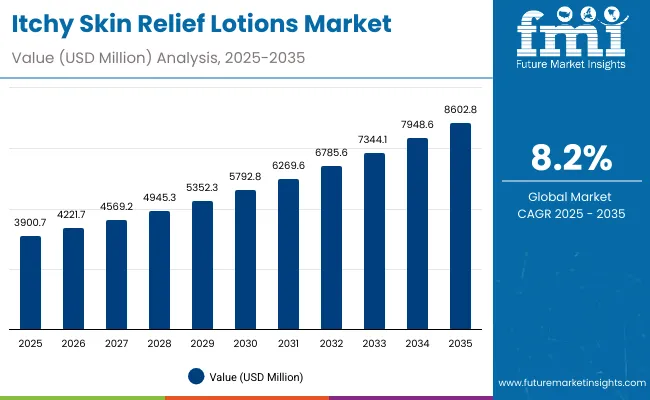
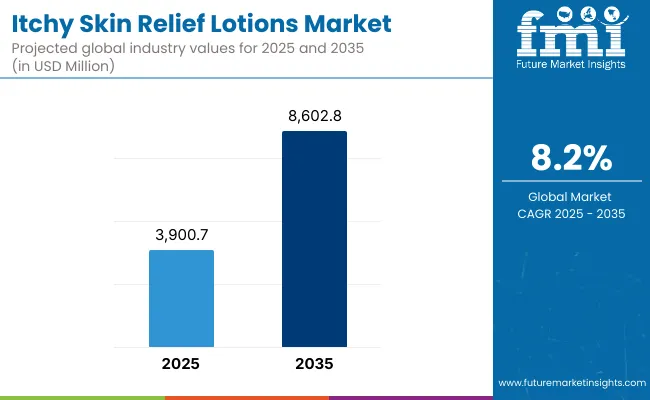
Itchy Skin Relief Lotions Market Key Takeaways
| Metric | Value |
|---|---|
| Itchy Skin Relief Lotions Market Estimated Value in (2025E) | USD 3,900.7 Million |
| Itchy Skin Relief Lotions Market Forecast Value in (2035F) | USD 8,602.8 Million |
| Forecast CAGR (2025 to 2035) | 8.2% |
During the first half of the outlook, between 2025 and 2030, the market is expected to expand from USD 3,900.7 Million to USD 5,792.8 Million, adding nearly USD 1,892.1 Million in value, which accounts for around 40% of total decade growth.This period is set to be characterized by the continued dominance of adult end users, who are projected to hold 59.6% of the market in 2025, and by pharmacies/drugstores leading channel share at 50.5%.Pharmacist trust and OTC accessibility are anticipated to anchor demand through this phase, while growing interest in hypoallergenic claims reinforces premium positioning.
From 2030 to 2035, acceleration is expected as the market rises from USD 5,792.8 Million to USD 8,602.8 Million, contributing USD 2,810 Million, or nearly 60% of the decade’s incremental value.This stage will likely be driven by rapid adoption in Asia, particularly China, India, and Japan, where CAGR levels surpass global averages.The strengthening of digital pathways, coupled with greater reliance on dermatologist-recommended routines, is anticipated to further expand category participation and sustain momentum.
From 2025 to 2035, the market is expected to more than double in size, reflecting resilient consumer demand for dermatologist-endorsed products and continued reliance on pharmacy-led distribution. Growth momentum will be fueled by emerging Asia, where double-digit CAGRs are projected, while the USA and Europe will consolidate share through scale, premiumization, and consistent regulatory standards. Competitive advantage will increasingly be shaped by evidence-based claims, clinical validation, and trust-driven marketing.
The growth of the Itchy Skin Relief Lotions Market is being propelled by rising awareness of skin sensitivity and the increasing prevalence of itch-related conditions across diverse age groups. Demand is being supported by greater reliance on dermatologist recommendations and the availability of trusted OTC solutions through pharmacies and drugstores.
Hypoallergenic formulations and clean-label positioning are gaining traction, as consumers seek safer and irritation-free options for long-term use. Expansion in emerging markets such as India, China, and Japan is being fueled by strong CAGRs, driven by rising disposable incomes, urban lifestyles, and growing health consciousness.
Advances in active ingredients such as colloidal oatmeal, aloe vera, and ceramides are reinforcing product efficacy and consumer trust, further accelerating adoption. Digital engagement, pharmacist guidance, and expanding e-commerce access are expected to widen the consumer base. Growth is anticipated to remain strong as clinical validation, transparency in claims, and premium positioning continue to define competitive advantage.
The Itchy Skin Relief Lotions Market has been segmented across end user, distribution channel, and product claims, reflecting the core demand drivers that shape purchasing behavior and brand positioning. Each segment demonstrates unique growth dynamics, with adults sustaining majority usage, pharmacies and drugstores acting as pivotal distribution points, and hypoallergenic claims gaining traction as trust-oriented differentiators.
Market evolution is expected to be influenced by lifestyle changes, increasing dermatological awareness, and clinical endorsement, which together reinforce the importance of segment-specific strategies. As adoption patterns shift, competitive advantage is anticipated to be defined by the ability to align product offerings with consumer needs across these three dimensions.

| End User | Market Value Share, 2025 |
|---|---|
| Adults | 59.6% |
| Others | 40.4% |
The end user segment is expected to remain dominated by adults, who are projected to hold a 59.6% share in 2025, equivalent to USD 2,324.2 Million. This dominance is supported by the high incidence of itchy skin conditions in adult populations, where lifestyle stress, pollution, and chronic dermatological issues drive continued reliance on topical relief solutions. Others collectively account for 40.4% of value, translating to USD 1,576.04 Million, which highlights notable potential in pediatric and elderly groups.
Over the forecast period, education campaigns and physician recommendations are likely to improve adoption among underserved cohorts. Increasing sensitivity awareness and wider insurance or OTC coverage are expected to reinforce adult dominance while broadening usage in non-core groups.
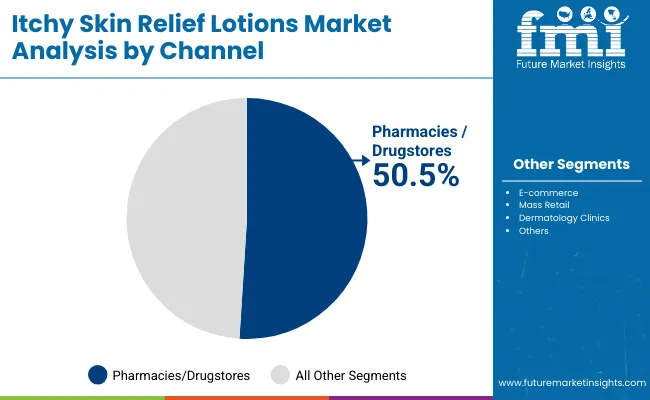
| Channel | Market Value Share, 2025 |
|---|---|
| Pharmacies/drugstores | 50.5% |
| Others | 49.5% |
The distribution channel landscape is anticipated to remain balanced but slightly skewed toward pharmacies/drugstores, which hold 50.5% of market share in 2025, amounting to USD 1,969.7 Million. Pharmacies are regarded as trusted points of access where pharmacist endorsements play a critical role in shaping purchase behavior. The others category accounts for 49.5%, valued at USD 1,930.65 Million, reflecting the rising influence of e-commerce and retail stores in expanding reach and convenience.
Forward-looking trends suggest that hybrid models integrating in-store expertise with digital platforms will drive incremental growth. Pharmacies are expected to sustain their lead through credibility and adjacency to clinical recommendations, while modern trade and digital channels are anticipated to intensify competition.
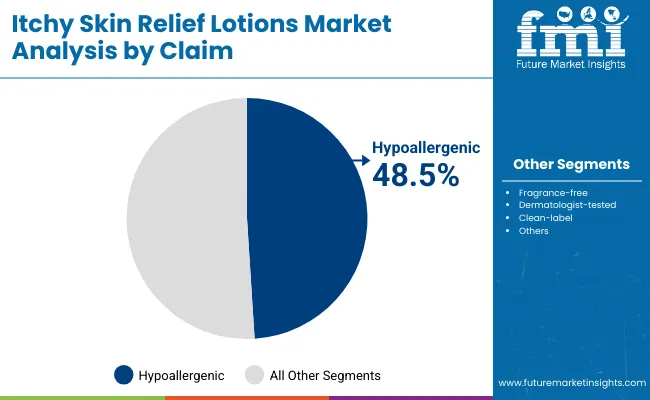
| Claim | Market Value Share, 2025 |
|---|---|
| Hypoallergenic | 48.5% |
| Others | 51.5% |
The claim-based segmentation indicates significant consumer interest in hypoallergenic positioning, which is set to account for 48.5% of value in 2025, representing USD 1,890.9 Million. Products under this category are preferred for their promise of minimal irritation, particularly in sensitive-skin cohorts where long-term usage is common.
Others collectively hold a 51.5% share, equivalent to USD 2,009.45 Million, underscoring the diversity of claims such as fragrance-free, dermatologist-tested, and clean-label. Over the forecast period, transparency in claim architecture and outcome-based communication are expected to reinforce trust and stimulate brand differentiation. Hypoallergenic offerings are anticipated to gain more visibility as consumer preference for safety and dermatologist-verified solutions continues to strengthen globally.
Complex formulation requirements and stringent efficacy validation are presenting challenges, even as consumer reliance on sensitive-skin solutions expands globally. Market growth is being shaped by shifting dermatological priorities, transparent claim frameworks, and increasing regulatory scrutiny on ingredient safety and labeling.
Clinical Validation as a Growth Catalyst
Clinical endorsement is being positioned as a pivotal driver for the Itchy Skin Relief Lotions Market. Products with substantiated claims validated by dermatologists or supported through clinical trials are anticipated to gain preference, particularly among informed consumer groups in mature markets.
This shift is creating differentiation where efficacy is not only perceived but also proven, anchoring premiumization strategies and expanding consumer loyalty. Over the next decade, manufacturers are expected to invest heavily in post-marketing surveillance and real-world evidence to secure competitive advantage. Such validation is projected to influence brand trust and accelerate adoption across channels, especially in pharmacies where clinical credibility aligns closely with consumer decision-making behavior.
Digital Health Integration in Consumer Skincare
Integration of digital health ecosystems into skincare routines is emerging as a defining trend. Skin-tracking apps, tele-dermatology platforms, and AI-driven skin assessment tools are being utilized to recommend personalized itch-relief solutions. This trend is expected to deepen consumer engagement, promote adherence to recommended regimens, and generate actionable data for formulators.
By linking real-time skin condition monitoring with product guidance, companies are projected to expand recurring revenue streams and strengthen positioning as solution-oriented providers rather than just lotion manufacturers. The convergence of skincare and digital health is anticipated to redefine category growth by fostering personalized pathways and evidence-driven consumer trust.
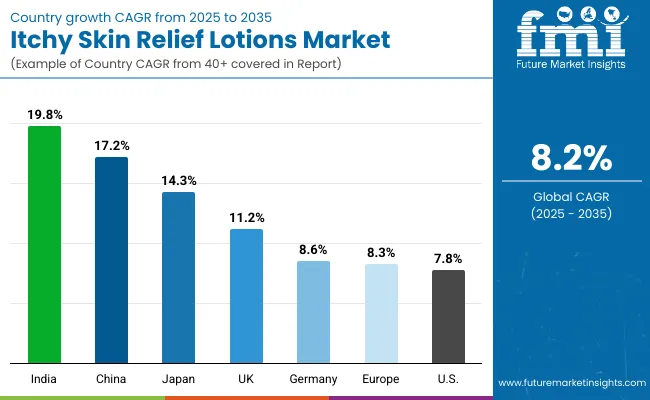
| Country | CAGR |
|---|---|
| China | 17.2% |
| USA | 7.8% |
| India | 19.8% |
| UK | 11.2% |
| Germany | 8.6% |
| Japan | 14.3% |
The global Itchy Skin Relief Lotions Market demonstrates strong variation in country-level growth, shaped by consumer dermatological awareness, healthcare access, and distribution strength. India is projected to lead with a 19.8% CAGR, supported by rising middle-class consumption, expanding dermatology clinics, and broader acceptance of sensitive-skin products.
China, advancing at a 17.2% CAGR, is expected to benefit from pharmacist-driven distribution and rapid urban adoption, alongside strong e-commerce penetration that accelerates consumer access. Japan follows with a 14.3% CAGR, where aging demographics and focus on skin health are fostering adoption of dermatologist-verified, hypoallergenic solutions.
In Europe, a steady CAGR of 8.3% is anticipated, with Germany at 8.6% and the UK at 11.2%, reflecting robust healthcare infrastructure and emphasis on claim transparency. Demand is likely to remain anchored by stringent safety standards and physician-led recommendations.
The USA is expected to grow at 7.8% CAGR, reflecting maturity of the category and strong OTC positioning, with pharmacies sustaining their role as trusted points of purchase. Overall, emerging Asia is forecasted to outpace Western markets, driven by double-digit growth corridors in India and China, while established regions will continue contributing steady value through scale, brand trust, and regulatory compliance.
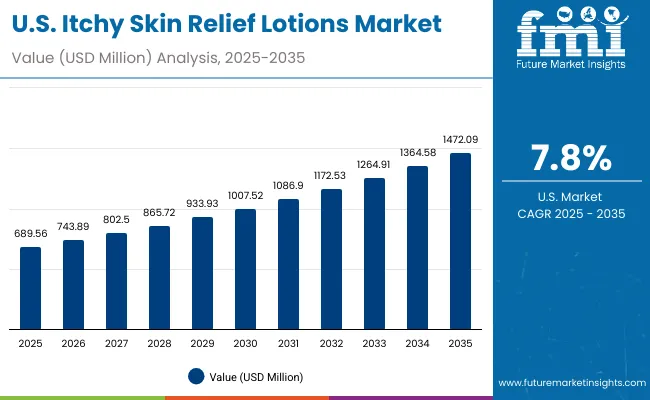
| Year | USA Itchy Skin Relief Lotions Market (USD Million) |
|---|---|
| 2025 | 689.56 |
| 2026 | 743.89 |
| 2027 | 802.50 |
| 2028 | 865.72 |
| 2029 | 933.93 |
| 2030 | 1,007.52 |
| 2031 | 1,086.90 |
| 2032 | 1,172.53 |
| 2033 | 1,264.91 |
| 2034 | 1,364.58 |
| 2035 | 1,472.09 |
The Itchy Skin Relief Lotions Market in the United States is projected to grow at a CAGR of 7.9%, driven by steady reliance on pharmacy-based distribution and the increasing need for dermatologist-endorsed solutions. Year-on-year growth is being reinforced by the adoption of hypoallergenic formulations, which continue to anchor premium demand in sensitive-skin categories.
The adult consumer group is expected to dominate the market throughout the forecast period, with stable purchasing behavior supporting category resilience. Expansion in e-commerce and digital platforms is anticipated to enhance product accessibility, complementing offline channels and driving incremental gains.
The Itchy Skin Relief Lotions Market in the United Kingdom is projected to grow at a CAGR of 11.2%, supported by high consumer awareness of sensitive-skin needs and strong reliance on dermatologist recommendations. Growth is anticipated to be reinforced by the availability of hypoallergenic and clean-label formulations that align with rising demand for transparency in product claims.
Pharmacies are expected to remain central to sales, benefiting from clinical proximity and OTC trust. Digital engagement and e-commerce platforms are forecast to amplify reach, particularly among younger demographics seeking convenient access to dermatologist-verified products.
The Itchy Skin Relief Lotions Market in India is forecast to expand at a CAGR of 19.8%, making it the fastest-growing market globally. Rapid urbanization, rising disposable incomes, and increased dermatological awareness are expected to fuel adoption, particularly in urban centers.
Pharmacies and retail stores are anticipated to anchor growth, while e-commerce is projected to widen reach across semi-urban and rural areas. Demand for hypoallergenic formulations is expected to rise sharply as sensitive-skin awareness accelerates. India’s large young population, combined with targeted brand campaigns, is projected to drive category penetration and premiumization.
The Itchy Skin Relief Lotions Market in China is projected to grow at a CAGR of 17.2%, reflecting robust demand across both pharmacy and e-commerce channels. Pharmacies/drugstores are expected to contribute over half of sales in 2025, supported by pharmacist trust and OTC positioning.
Rapid adoption of digital platforms, including social commerce and tele-dermatology integration, is anticipated to reinforce accessibility and consumer education. Sensitivity-focused claims such as hypoallergenic and dermatologist-tested are forecast to drive premium adoption, aligning with evolving consumer expectations. China is projected to emerge as one of the leading markets globally by the end of the forecast period.
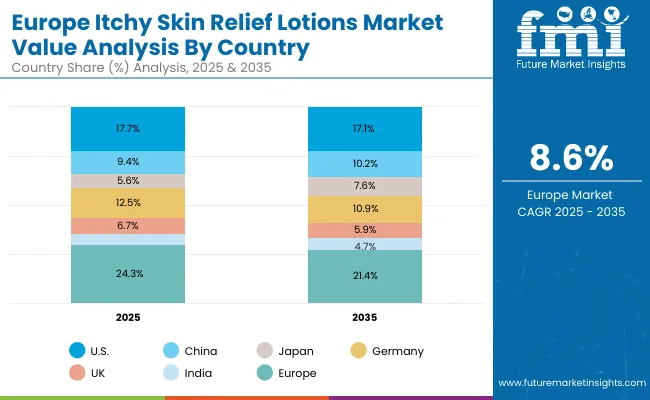
| Country | 2025 |
|---|---|
| USA | 17.7% |
| China | 9.4% |
| Japan | 5.6% |
| Germany | 12.5% |
| UK | 6.7% |
| India | 4.3% |
| Country | 2035 |
|---|---|
| USA | 17.1% |
| China | 10.2% |
| Japan | 7.6% |
| Germany | 10.9% |
| UK | 5.9% |
| India | 4.7% |
The Itchy Skin Relief Lotions Market in Germany is expected to grow at a CAGR of 8.6%, supported by a highly structured healthcare system and strict adherence to claim transparency. Growth will be driven by dermatologist endorsements, which hold strong influence over consumer purchase decisions.
Pharmacies remain the dominant channel, benefiting from clinical credibility and consumer trust. Hypoallergenic and fragrance-free positioning are expected to anchor premium segment adoption, particularly in sensitive-skin categories. The market is projected to demonstrate steady expansion, reflecting both consumer trust in regulated claims and consistent product innovation.
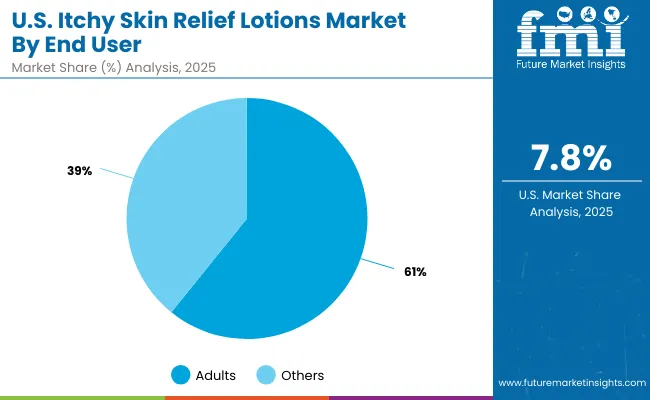
| USA by End User | Market Value Share, 2025 |
|---|---|
| Adults | 60.5% |
| Others | 39.5% |
The Itchy Skin Relief Lotions Market in the USA is projected at USD 689.56 Million in 2025. Adults contribute 60.5% (USD 417.2 Million), while others account for 39.5% (USD 272.4 Million), which highlights the dominance of adult consumers in category adoption. This skew toward adults stems from higher prevalence of chronic itch-related conditions, stress-driven sensitivities, and broader access to OTC products tailored to adult routines. Pediatric and elderly segments remain underpenetrated, yet opportunities are emerging as awareness of sensitive-skin care expands through dermatologist recommendations and retail education campaigns.
Over the next decade, adult dominance is expected to continue, while incremental share gains among “others” are likely as specialized formulations address age-related skin dryness and pediatric needs. E-commerce accessibility and increasing personalization are anticipated to improve reach across diverse cohorts, reinforcing steady expansion in both categories.
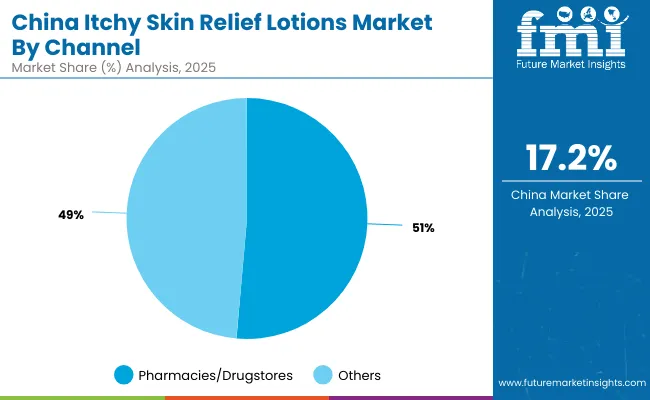
| China by Channel | Market Value Share, 2025 |
|---|---|
| Pharmacies/drugstores | 51.4% |
| Others | 48.6% |
The Itchy Skin Relief Lotions Market in China is projected at USD 367.84 Million in 2025. Pharmacies/drugstores contribute 51.4% (USD 189.1 Million), while other channels hold 48.6% (USD 178.75 Million), highlighting a near-balanced distribution landscape. Pharmacies are expected to retain leadership due to strong pharmacist influence, OTC trust, and consumer reliance on professional recommendations. This advantage is reinforced by proximity to clinical care and regulatory clarity, which strengthen credibility in product claims.
Other channels, including e-commerce and modern retail, are anticipated to rapidly expand reach, driven by digital health integration, social commerce, and growing consumer preference for convenient access. Over the next decade, this near-equal distribution is expected to create a competitive dynamic where pharmacies maintain authority in clinical trust, while online and retail channels accelerate volume growth.
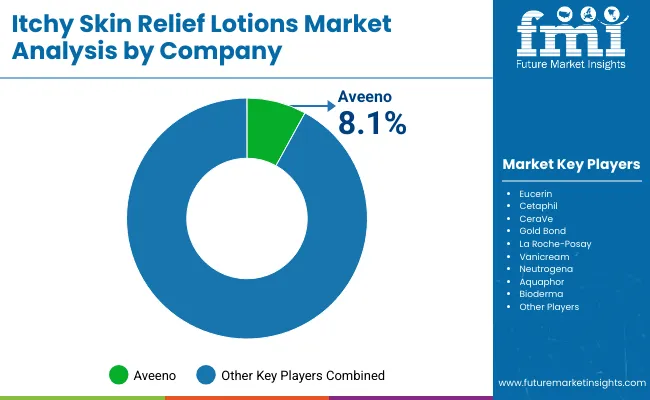
| Company | Global Value Share 2025 |
|---|---|
| Aveeno | 8.1% |
| Others | 91.9% |
The Itchy Skin Relief Lotions Market is moderately fragmented, with global leaders, regional brands, and niche-focused players competing across distribution channels and consumer segments. Aveeno is positioned as the dominant player with 8.1% global value share in 2025, while all other competitors collectively hold 91.9%, indicating a highly competitive landscape with no single brand exceeding double-digit share.
Aveeno’s leadership is reinforced by strong dermatologist endorsements, premium hypoallergenic positioning, and consistent presence in pharmacy channels. Its strategies are expected to emphasize sensitive-skin formulations, claim transparency, and integrated digital campaigns to sustain growth.
Other established brands such as Eucerin, Cetaphil, CeraVe, Gold Bond, La Roche-Posay, Vanicream, Neutrogena, Aquaphor, and Bioderma are projected to strengthen their positions by focusing on claim-specific innovation, dermatologist advocacy, and trust-based consumer engagement. Their competitive differentiation lies in leveraging brand heritage, localized marketing, and expanding distribution in emerging markets. Smaller regional brands are likely to focus on affordability, clean-label claims, and expanding e-commerce footprints, thereby adding further intensity to market competition.
Competitive advantage is expected to shift away from generic formulations toward clinically validated, dermatologist-tested solutions supported by transparency in ingredient sourcing. Digital outreach, oMillionichannel strategies, and evidence-based claim communication are anticipated to define leadership in the next decade.
Key Developments in Itchy Skin Relief Lotions Market
| Item | Value |
|---|---|
| Quantitative | USD 3,900.7 Million (2025); USD 8,602.8 Million (2035); 8.2% CAGR (2025 to 2035) |
| Product Forms | Lotions (focus category), creams, balms, gels |
| Active Ingredients | Colloidal oatmeal, aloe vera, ceramides, urea, pramoxine |
| Claims | Hypoallergenic, fragrance-free, dermatologist-tested, clean-label |
| Distribution Channels | Pharmacies/drugstores, e-commerce, mass retail, dermatology clinics |
| End Users | Adults, Others (children & elderly) |
| Regions Covered | North America, Europe, Asia-Pacific, Latin America, Middle East & Africa |
| Countries Covered | United States, China, India, Japan, Germany, United Kingdom |
| Key Companies Profiled | Aveeno, Eucerin, Cetaphil, CeraVe, Gold Bond, La Roche-Posay, Vanicream, Neutrogena, Aquaphor, Bioderma |
| Additional Attributes | Dollar sales by end user, channel, and claim; pharmacy-led OTC penetration; growth in hypoallergenic positioning; e-commerce acceleration; evidence-based claims and dermatologist endorsement; regulatory emphasis on safety/labeling; ingredient innovation for barrier support and itch relief; double-digit growth corridors in India and China; steady expansion in the USA and Europe. |
The global Itchy Skin Relief Lotions Market is estimated to be valued at USD 3,900.7 Million in 2025.
The market size for the Itchy Skin Relief Lotions Market is projected to reach USD 8,602.8 Million by 2035.
The Itchy Skin Relief Lotions Market is expected to grow at a CAGR of 8.2% between 2025 and 2035.
The key product types in the Itchy Skin Relief Lotions Market include lotions, creams, balms, and gels.
In terms of end users, the Adults segment is set to command 60.5% share in 2025, equating to USD 2,324.2 Million.






Full Research Suite comprises of:
Market outlook & trends analysis
Interviews & case studies
Strategic recommendations
Vendor profiles & capabilities analysis
5-year forecasts
8 regions and 60+ country-level data splits
Market segment data splits
12 months of continuous data updates
DELIVERED AS:
PDF EXCEL ONLINE
Skin Lightening Product Market Size and Share Forecast Outlook 2025 to 2035
Skincare Supplement Market Size and Share Forecast Outlook 2025 to 2035
Skin Tightening Device Market Size and Share Forecast Outlook 2025 to 2035
Skincare Oil Market Size and Share Forecast Outlook 2025 to 2035
Skin-Barrier Strengthening Phospholipids Market Size and Share Forecast Outlook 2025 to 2035
Skin Toner Market Size and Share Forecast Outlook 2025 to 2035
Skin Cancer Detection Devices Market Size and Share Forecast Outlook 2025 to 2035
Skincare Nutritional Serum Market Size and Share Forecast Outlook 2025 to 2035
Skincare Products Market Size and Share Forecast Outlook 2025 to 2035
Skin Sensors Market Size, Growth, and Forecast for 2025 to 2035
Skin Grafting System Market Size and Share Forecast Outlook 2025 to 2035
Skincare Market Analysis - Size, Share, and Forecast Outlook 2025 to 2035
Skincare Packaging Market Size, Share & Forecast 2025 to 2035
Skin Perfusion Pressure Testing Devices Market Size and Share Forecast Outlook 2025 to 2035
Skin Care Devices Market Analysis - Trends & Forecast 2025 to 2035
Skin Antiseptic Market - Demand, Growth & Forecast 2025 to 2035
Skin Bioactive Market Analysis - Trends, Growth & Forecast 2025 to 2035
Skin Replacement Market Growth - Trends & Forecast 2024 to 2034
Skin Tears Treatment Market Growth – Industry Outlook & Forecast 2024-2034
Skin Lightening Lip Balm Market Trends – Demand & Forecast 2024-2034

Thank you!
You will receive an email from our Business Development Manager. Please be sure to check your SPAM/JUNK folder too.
Chat With
MaRIA